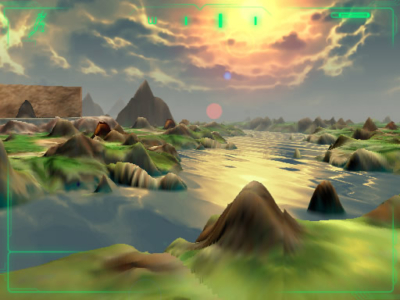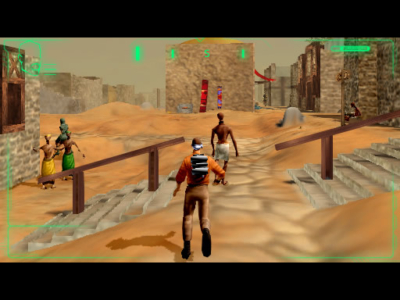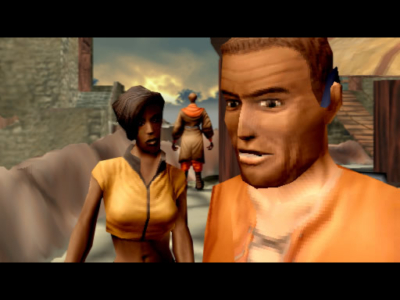
Outcast
Written by: Stoo
Date posted: January 27, 2007
- Genre: Action
- Developed by: Appeal
- Published by: Infrogames
- Year released: 1999
- Our score: 10
This is a story about discovery and adventure in a strange alien world. A story about the people of that world, suffering under tyranny and oppression, and awaiting a champion to who will lead them to freedom. It’s a story about the reluctant hero who finds he must take on this duty. It’s a story of betrayal, and hope, and endurance. It’s also a story about volumetric pixels, would you believe.
Welcome to Outcast. It’s an action-adventure with first and third-person options, but don’t let any screenshots of the game in third-person mode put you in a Tomb Raider frame of mind. It’s rather more of a hybrid in nature. There’s exploration, shootouts, a fair bit of “go find an item” style questing, and maybe just a little jumping over ledges and platforms. Also, in case you’re already read other reviews, don’t let any criticisms of “good god these people talk too much” put you off. Well, there is a lot of talking, but at least wait until I’ve had a chance to outline why it’s worth putting up with.
The intro is a long one, for sure, so you probably want to make a cup of tea or something beforehand. It begins with scientists meddling with things beyond their understanding, exploring trans-dimensional portals. They manage to open a portal to another world, and send a probe through. Except that something on the others side attacks the probe, the portal backfires in a catastrophic manner, and the earth is at risk of destruction. Okay, it’s hokey scifi nonsense, but bear with me. A team of scientists is assembled to go through the portal, find the probe and reverse the damage. Their military babysitter on this mission is Cutter Slade, the square-jawed but slightly sardonic US Navy Seal.
Except, on the other side, things go somewhat awry. Cutter wakes up in a hut in a snowy village, with a bizarre looking nearly-humanoid alien gazing at him. At this point, a whole load of exposition is dropped on his head. It turns out our hero is on the world of Adelpha, which is currently in the iron grip of a tyrant and his armies. The portal has, as luck would have it, deposited Cutter right on top of the resistance movement, hidden away in their base in the mountains. Appearing as he did from nowhere, with awesome technologies they deem as sacred objects, the resistance has decided that Cutter he must be their prophecised “Ulukai”, or saviour. His role, according to their legends, is to spearhead their movement to overthrow the tyrant. Not exactly what he signed up for, but Cutter has to agree out of necessity. He will do his bit to help these people, and the rebels will help look for the probe and scientists.
So, again, that’s quite a while sat there listening to people explain stuff to you. I hope you can make it that far, as patience will be rewarded. Pretty soon you’ll be itching to run around and actually do something – so thankfully you’re let loose into the pretty village, a kind of tutorial area before the game proper. You can jump around in the snow, get used to the interface, shoot at inanimate objects and learn a few useful tricks such as stealthy movement.
So let’s look at the world of Adelpha. The game sees you roaming several large outdoor areas – that’s an immediate plus point in my book, as I do like to do some exploring in my gaming. The terrain is rendered using voxels, that is, pixels arranged in three-dimensional space. It’s an alternative to the polygon-based graphics we’re more accustomed to in 3D gaming. The use of such technology was slightly controversial at the time – Novalogic had stuck with it through the 90s for their military sims, but most other developers chose not to adopt it. Right away you can see the downside: a pixellated, grainy look that was a signature feature of voxels. Even at the time reviewers were commenting on it looking “retro” – being stuck at rather low resolutions doesn’t help in this respect.
For the upside, you need to compare with other games of the time, such as Half-Life or Tom Raider. The polygon-based engines were fine for doing buildings, but natural terrain was more difficult. Little details and rounded features couldn’t be done easily without lots of tiny triangles, which could cause an unacceptable hit to performance given the PCs of 1999. So their exterior locations tended to be a fairly obvious arrangement of flat surfaces, giving them a hard, smooth feel even with texturing. The lands of Outcast however are more detailed, much more natural and organic in style. Well, there are lots of slightly surreal rocky spires, but that could just be a design choice. The point being ridges, hills, ponds, dips in the ground etc could be handled more convincingly, without placing so much of a demand on the hardware.
This leads to some environments you can properly immerse yourself in. One of my favourite areas is the murky wetland, with a small town clustered on a steep hill by the still shores of a lake, and the sun peering dimly through the skies. You can almost feel the damp in the air, and believe that’s mud under Cutter’s boots instead of computer geometry. Other regions include a forest, dotted with ruins and a picturesque little river, and a desert city. For sheer size the game’s world isn’t on a par with the rolling vastness of say Oblivion. It’s still decently sized, though and also well detailed and varied. So there’s definitely some fun in just exploring and sightseeing.
Of course it still looks somewhat dated; modern 3D engines have improved greatly in rendering of outdoor terrain, helped by fancy texturing tricks and more powerful hardware. Any such advantages I might argue for Voxels in 1999 don’t really apply anymore. They proved to be a dead end and are now little more than a curiosity of gaming history. Still the environments of Outcast remain highly atmospheric nonetheless, their distinctive style carries a unique charm. Even if it’s a voxelly one.
I have to mention the sountrack too. Simply because, it’s one of the best ever heard in a game. What’s more, it’s a highly professional job. We’re not just talking some guy churning out computer music in his studio. Rather it’s performed by the Moscow Symphony Orchectra, no less. Ranging from moody and ominous, to sweeping and awe-inspiring, it’s a clear cut above much of what we normally get in gaming.
The land meanwhile is populated by a multitude of the Talan (as they call themselves). Whilst some do just kind of mill around in that usual gaming-NPC manner, many do actually carry out simple tasks. Merchants carry boxes of their wares around, miners sing as they they swing away with pickaxes, and rice farmers work through their fields. Some characters will lie down for a sleep sometimes, and slightly randomly others like to do push-ups. Okay, so it’s just a few scripted animations, but efforts like this go a long way towards that illusion of making Adelpha into “living” world, as opposed to just a set of gaming maps. Thus you’re that important bit more interested in what takes place within it.
You’ll pretty soon be reminded again these guys talk a lot – this is not a game to hand out a few snappy clues and objectives. In fact they’re liable to ramble on at length about their job, their thoughts on the soldiers, something they want you to do, a funny thought that occurred to them last night, and so on. Most generic Talans draw their comments from a few stock sets, depending on region. Those who are relevant to some quest or plot element tend to have more individuality – you’ll meet greedy amoral merchants, slow-witted supervisors, grumpy priests and so on. Here’s one more nice touch – you can ask most characters for the location of any other, and not only will they tell you what direction to head in, they’ll even physically point if that person is nearby.
It’s fortunate that the voice acting is usually of a decently high standard. Also the game keeps a sense of humour about it during these exchanges. Not to the point of being a fully comic affair, just an awareness of how ridiculous Cutter’s situation sometimes looks. He’s usually slightly bemused or exasperated by the chores he’s being given or the eccentricities of the Talan, in an “oh fantastic, now what?” manner. Sometimes they then briefly take on the role of the straight man, when he vents his frustration in a sarcastic manner that flies right over their slightly naive heads.
What complicates matters though is the proliferation of made-up words, mostly nouns. I can see the reasoning behind this – making the world and its people seem a little more alien. Still after a while it gets a bit much: Douka (portal between regions), Shamazaar (priest), yon(don’t recall), mon(sacred object), hoti (fruit), mazgrab(completely forgotten), riss(food), oogabar (forgot), Twon-ha (beast of burden). I probably spelled a few wrong there. Add on top of this the names of the multitude of people you’ll need to track down, often quite similar-sounding, and it’s a damn good thing the game has a built-in glossary.
Anyway though it’s not all talking, action fans relax as there’s plenty of fighting too. The land is populated both by dangerous monsters, and soldiers of the tyrant. The AI was apparently somewhat hyped at the time – it’s not really clever, but soldiers will dodge and occasionally run away at least, rather than just purely charging at you. You have a selection of six weapons – such as a kind of railgun-pistol, flamethrower and something that looks rather like a hairdryer but fires big glowing energy blasts. Combat can maybe get a little repetitive, but it’s also something you can largely find or avoid at your own pace, as enemy patrols are easy to dodge. In fact the freedom to survey the terrain, choose to attack or run, pick the best direction to come from etc is very welcome. Also you can count on decently responsive controls – in 3rd person with the mouse controls your view, so no fear of unhelpful camera angles that sometimes blight 3rd person gaming.
For variety’s sake, you can have a go at the aforementioned stealth too. It’s not exactly Thief in terms of detail here – just a matter of staying out of enemy’s fields of view, without factoring in things like footsteps or illumination. However, you can at least use cover, commando-crawling through the ditches to stay out of sight, and try a sneak attack. Or for added fun, sneak into an enemy base, drop dynamite, creep away to a safe spot, detonate, and watch rubble and soldiers fly around. Heh.
Although you can have some free-roaming fun in that manner, causing grief for enemy patrols, there’s a lot of questing to be done too. The main storyline quest has four main components, each in a different region, revolving around retrieving sacred objects of the Talan. Yup, it’s a magic trinket hunt, but believe me its more involving than it sounds. There are also four secondary missions, which are effectively about striking against the infrastructure supporting the enemy soldiers. Completing one cuts off their food supply, resulting in a halving of hit points, another reduces the power of their weapons. It’s a neat idea, and encouraging to have all your running about produce some real tangible results.
It’s never simple going about these tasks, however. You might have to find a priest, who’s imprisoned, so you talk to someone who knows how to get him out, but that person won’t help until you aid him with his fruit farm, so you have to run half-way across the land to a craftsman who can make a tool the merchant needs. But the craftsmen sent his brother to do some shopping a month ago and he hasn’t returned, so you’ll have to track him down… I’m making the specifics up here, and exaggerating, but it’s the kind of process the game puts you through. On top of this are numerous one-off side quests, not so lengthy but again usually involving running errands.
For all the running about it never gets tedious, though. Thanks to the way the land of Adelpha and its people are brought to life, you feel that what you do here actually matters. You’re genuinely helping the Talan. So while the gameplay is itself very well done, the sense of your actions serving some purpose gives you extra incentive to complete the missions, and this is what drives you through the game. You’re not just some random adventurer, you’re a hero the people; they’re looking to you to inspire them and lead them to a better future.
As the missions progress, elements of the main narrative are woven in. So from complete befuddlement, you start to get an idea of what’s going on, and why Adelpha is currently in this state. Maybe Cutter’s arrival here wasn’t such an accident after all. There’s some decent storytelling going on here, helped by how the writers took the effort to properly develop the character of Cutter and some of the supporting cast, and with some twists along the way too. Okay, plot and story in gaming still lags behind what we might ask for in other forms of media, but within this context Outcast does pretty well for itself. There’s drama, humour and moments of genuine sadness, based around believable (even if sometimes eccentric) characters.
So to complain too much about whatever few frustrations Outcast brings up along the way seems rather churlish. Yeah the people talk a lot, but it’s not a critical issue and the game’s strengths are far more important. It gives you a fairly large, and certainly well-detailed environment, with plenty of action and interaction. It provides some half-decent action to go with that. Also, and this is a key point, it tries its best to make you actually care what goes on here. That’s what makes it an involving adventure experience; you can really get into the tale of how Cutter, despite his misgivings, become saviour of Adelpha.
So then this one is well qualified for FFG classic status. Just try to keep a handle on made up words, and make a note of whether it’s zalan, zartes or zorta you need to deliver the hoti to at the riss bok.





 Posts
Posts
Also available slightly enhanced as Outcast 1.1 on Steam.
February 24, 2015 @ 12:56 am